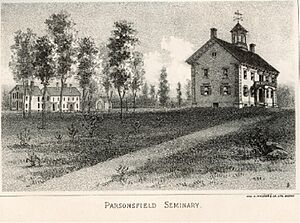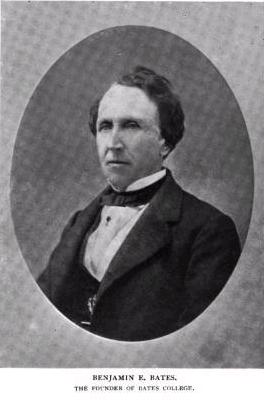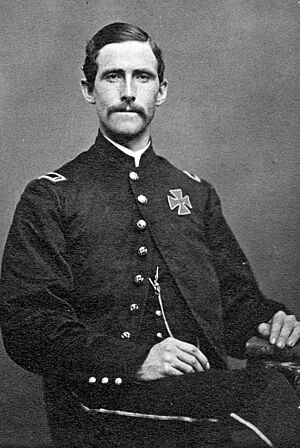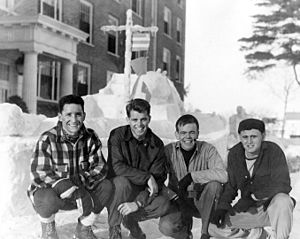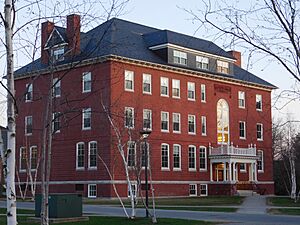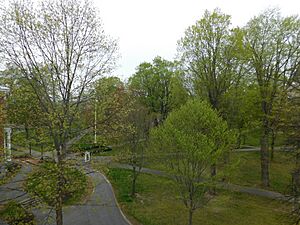History of Bates College facts for kids
The history of Bates College began even before the college was officially founded on March 16, 1855, in Lewiston, Maine. The college was started by Oren Burbank Cheney and Benjamin Bates. It began as a school connected to the Free Will Baptist church, but later became a non-religious (secular) school. Bates College focuses on a liberal arts curriculum, which means students learn a wide range of subjects.
After a school called Parsonsfield Seminary mysteriously burned down in 1853, Cheney wanted to create a new school. He chose Lewiston, Maine, because it was a growing industrial city. Cheney met with important religious and political leaders to plan the new school. They successfully asked the Maine State Legislature to create the Maine State Seminary. When it opened, it was the first college in New England where both boys and girls could study together. Rich donors soon helped pay for the seminary, building it in a nice part of Lewiston.
However, the college faced money problems after a financial crisis in 1857. To help the school stay open, a wealthy businessman named Benjamin Bates donated a lot of money. Because of his generosity, the school was renamed "Bates College" in his honor in 1863. The college was known for helping runaway black slaves. Its first African American student, Henry Wilkins Chandler, graduated in 1874. Two other schools, the Cobb Divinity School and the Nichols Latin School, also became connected with Bates in 1866.
Even though few women attended Bates in its early days, Mary Mitchell Birchall was one of the first women to graduate from a New England college. In the early 1870s, Bates started a friendly rivalry with Bowdoin College. Many teachers sometimes worked at both schools, and they even shared some leaders. Gridley J. F. Bryant designed Bates' first buildings, Hathorn Hall and Parker Hall. During the Civil War, Bates was important in supporting the rights of African Americans and women. Many students strongly supported the Emancipation Proclamation, which freed slaves. They spoke out in their communities for freedom and civil rights.
Bates sent 175 students to fight in the Civil War. Some famous students included Holman Melcher, Aaron Daggett, and James Porter. After the war, George Colby Chase became the first president who had also graduated from Bates. He started the Outing Club, stopped early attempts to create secret societies, and created the Brooks Quimby Debate Council. This debate team became very successful internationally, making Bates College well-known in U.S. higher education.
In 1943, the V-12 Navy College Training Program was started at Bates, bringing students like Robert F. Kennedy. A ship was even named the S.S. Bates Victory after the college. In 1964, Bates, Bowdoin, and Colby College joined together to form the Colby-Bates-Bowdoin Consortium. This group made their football and rowing rivalries even stronger. In 1970, the college became fully non-religious. It also built many new academic, living, and sports buildings, including Pettengill Hall, the Residential Village, and the Bates College Coastal Center at Shortridge.
In 2002, Elaine Tuttle Hanson became Bates' first female president. She oversaw the building of "The Commons" and guided the college through the financial crisis of 2007-08. In 2012, Clayton Spencer became president. She brought new subjects to study, broke fundraising records, built new dorms, and launched a big fundraising campaign called "Bates+You."
Contents
19th Century History
Early Beginnings
Oren Burbank Cheney attended Parsonsfield Seminary, a religious school. He was concerned about racial segregation and unfair religious practices in American schools. He wanted to create a new school that would be open to everyone and offer strong academics. In 1836, Cheney went to Dartmouth College because it supported the abolitionist movement against slavery. This idea of fighting slavery became a key part of what Bates College would stand for. After graduating, Cheney became a Baptist minister and became known as an expert in education and religion.
The Parsonsfield Fire

Parsonsfield Seminary burned down in 1853, late at night. The exact details of the fire are not clear. Cheney said, "the bell tower flickered in flames while the children ran from its pillar-brick walls." It was believed that three students and two runaway slaves died in the fire. An investigation followed, but it was unsuccessful. The fire was thought to be an act of arson and murder. No one knows for sure why the Seminary burned down, but some believe it was caused by people who were against abolitionism. After the fire, Cheney pushed for a new seminary to be built in a different part of Maine.
Maine State Seminary Opens
The "Maine State Seminary" began offering liberal arts subjects in 1855. This made it one of the oldest liberal arts colleges in the United States. It was also the oldest college in New England where both boys and girls could study together. Cheney met with religious and political leaders in Topsham, Maine, to plan a school for Free Will Baptists. He wanted the school to be based on ideas of equality, freedom, and strong learning.
He gave a speech saying they wanted to create a school "of higher order" than an academy, but not quite a college. He promised to ask the state legislature for support again and again until they succeeded. His speech was well-received. Twenty-four petitions were sent to the Maine State Legislature. The charter was approved quickly, and the state gave $15,000 to start the school. With Cheney's influence, the Maine State Seminary was officially chartered on March 16, 1855. It offered both liberal arts and religious studies.
Getting Financial Support
The campus was built near Frye Street, which was a wealthy residential area in Lewiston. Soon after the school opened, many donors, including rich people from Boston, helped pay for parts of the school. For example, Seth Hathorn donated the first library and academic building, which was later named Hathorn Hall. The college faced financial difficulties in the late 1850s and needed more money to keep its funds stable.
Gridley J.F. Bryant, a famous architect from Boston, designed the college's first academic and residential buildings: Hathorn Hall and Parker Hall. This was special because Bryant usually designed buildings for very rich and powerful people. He often charged very high prices, but he offered his services at a discount for projects that he felt were personally or socially important. He believed in the school's support for abolitionism, which he also supported. The Hathorn Hall project received a lot of media attention because it was a smaller project compared to his other famous works, like the Massachusetts State House.
Benjamin Bates's Help
Benjamin Bates, a powerful businessman from Boston, became interested in the college because of Cheney's work in Maine. Bates donated $100,000 personally and contributed a total of $250,000 to the college. Benjamin Bates suggested to Cheney that the school should be in a more central part of Maine. Their past business connections led them to Lewiston Falls. At that time, Lewiston, Maine was one of the most profitable towns in the state. The school was renamed "Bates College" in his honor in 1863 and officially chartered the next year on March 16.
Cheney noted Bates's love for Lewiston and the college. He said Bates often told him, "I love Lewiston," and "I love the College."
Growing Academic Reputation
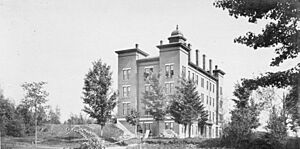
In 1862, the college graduated Frank Haven Hall, who later made big changes in modern computing and typography. Three years later, the college enrolled Mary Mitchel, the first woman to earn a college degree in New England. A small gym was built in 1867 for meetings and sports events. As more students joined, John Bertram Hall was built in 1868. It was first called Lyman Nichols Hall but was renamed to honor John Bertram, a naval captain and donor.
Bates College was already known for its strong academics and for being open to everyone. It mainly educated middle and working-class students from Maine. The school became famous for its focus on learning, including having three student literary societies. The college's official seal shows a stag deer near a pine tree, representing Maine's nature. It also has a single grain, a lighted oil lamp for "unwavering clarity," and an open book for "academic excellence."
The Cobb Divinity School became connected with the college in 1866. Four years later, in 1870, Bates supported a college preparatory school called the Nichols Latin School. Bates started with six teachers who taught subjects like moral philosophy and classics. Bates' first African American student, Henry Wilkins Chandler, graduated in 1874.
Bates and the Civil War
During the American Civil War, Bates College played an important role in supporting the rights of African Americans. Many alumni fought or served in the war. During this time, the Bates Board of Fellows was created. Important members included U.S. Secretary of State, James Blaine, and Governor of Maine, Nelson Dingley. When the Civil War began, President Cheney encouraged students to fight as a way to show their beliefs. His strong and unusual ideas made students think about the school's role.
Many students supported the Emancipation Proclamation, which declared slaves free. They spoke out in their communities for the freedom of African Americans and for general civil rights. The college sent 175 students to the war. One of them was Major Holman Melcher, who joined the 20th Regiment of Maine. His reasons for fighting were similar to those of other Bates students and leaders. Melcher became a Civil War hero and later the mayor of Portland, Maine. He was a Brevet Major and was part of the group that charged down Little Round Top at the Battle of Gettysburg.
He was the first person to charge down Little Round Top. The college also graduated the last surviving Union general of the American Civil War, Aaron Daggett. Another graduate was James Porter, one of General Custer's officers killed at the Battle of Little Bighorn. Historians have praised Porter as a leader who made strong decisions in difficult times. A total of three Bates alumni received the nation's highest military award, the Medal of Honor.
In 1884, the college graduated Ella Haskell, the first woman to argue a case in front of the U.S. Supreme Court. In 1894, George Colby Chase helped Bates gain more national recognition. The college also graduated Harry Lord, one of the founding members of the Boston Red Sox baseball team.
20th Century History
Early 1900s: Debate and Outing Club
During President Chase's time, Bates's debate team, which had existed since the school's beginning, started competing against other colleges. This helped Bates's academic reputation. In 1920, the Bates Outing Club was founded. It is one of the oldest college outing clubs in the country. It was the first at a private college to include both men and women from the start. It is also one of the few outing clubs still run entirely by students.
The Bates College debate team, called the Brooks Quimby Debate Council, was the first college debate team in the United States to compete internationally. In February 1920, the debate team beat Harvard College in a national debate tournament held in Lewiston. After this, Bates became known as a very strong force in college debating.
In 1921, Bates's debate team took part in the first intercontinental college debate in history. They debated against the Oxford Union's debate team at the University of Oxford in England. In 1922, The New York Times newspaper called Bates "the power centre of college debating in America." Oxford's first debate in the United States was against Bates in Lewiston, Maine, in September 1923. Also in 1923, U.S. President Calvin Coolidge received an honorary degree from Bates after he was elected president. Many new academic buildings were also built during the 1920s.
Mid-1900s: V-12 Program and CBB
In 1943, the V-12 Navy College Training Program was started at Bates. This program trained naval officers during World War II. Bates had a good number of female students, so it didn't lose as many students to military service as male-only colleges like Bowdoin and Dartmouth. During the war, a Victory Ship was named the SS Bates Victory after the college. It was during this time that Robert F. Kennedy, who would later become U.S. Attorney General, enrolled at Bates along with many other sailor-students.
Bates College began competing in sports with Colby College. In 1964, Bates, Colby, and Bowdoin created the Colby-Bates-Bowdoin Consortium. This group started the Chase Regatta in 1988, where Bates, Colby, and Bowdoin compete annually for the President's Cup. All three schools compete in the New England Small College Athletic Conference (NESCAC). They also share one of the ten oldest football rivalries in the United States. Bates's sports rivalries with other NESCAC schools date back to the 1870s. Bates and Tufts played the first football game in Maine on November 6, 1875, on the Bates campus. Bates and Bowdoin have had a baseball rivalry since at least the 1870s.
Late 1900s: Becoming Secular and Growing Campus
In 1967, President Thomas Hedley Reynolds encouraged the idea of teachers also being scholars at Bates. He also helped build many new academic and recreational buildings. Later that year, the college created its first official central administration, located in Lane Hall. Reynolds was also important in getting the Bates-Morse Mountain for the college. Under Reynolds, Bates stopped being officially connected to any particular religion. Although Bates was never a strictly religious college, it had historical ties to the Free Will Baptist church for 115 years. In 1970, this connection ended when the college catalog no longer described Bates as a "Christian college."
Bates College was part of a movement to make standardized test scores optional for college admission. In 1984, Bates became one of the first liberal arts colleges to make the SAT and ACT scores optional for applying. In 1989, Donald West Harward became president of Bates. He greatly expanded the college's buildings by adding 22 new academic, residential, and athletic facilities. These included Pettengill Hall, the Residential Village, and the Bates College Coastal Center at Shortridge.
21st Century History
Early 2000s: Campus Growth and Challenges
Elaine Tuttle Hansen became the seventh president and first female president of Bates College on October 26, 2002, in Lewiston, Maine. There were some tensions between the Bates community and the city of Lewiston. The college explained its importance to the city's development and history. In 2003, Bates noted that its operating budget of $65 million, though from outside Maine, was spent entirely within the state. This included nearly $6 million paid directly to about 360 businesses in the Lewiston and Auburn area. It also included $1.2 million paid directly to individuals. Bates mentioned that even though it was a tax-exempt organization, it paid $341,000 in fees and taxes to the city. Bates highlighted the economic impact of students and faculty on Lewiston, which was about $70 million in direct spending each year.
After Hurricane Katrina in late 2005, the college stopped requiring tuition from students affected by the hurricane. In 2005, May 2 was named "Bates College Day" by Governor of Maine, John Baldacci. In late 2007, Hansen announced the building of 280 Hall, a new residence hall for 150 students. In April 2008, Bates expanded its campus by finishing "The Commons" building, which cost about $24 million.
2007-2012: Financial Challenges
During the financial crisis of 2007-08, President Hansen shared notes from a meeting of the Board of Trustees. Students were worried about the college's financial stability and its ability to provide financial aid. Hansen explained that the college would need to change its 10-year financial plan to keep its promise to cover the financial needs of all admitted students. She said, "I recognize that these are times of stress and concern for all, but I want you to know that the Trustees and I have every confidence in the strength and perseverance of this institution and the entire Bates community."
In February 2008, a letter was sent to 136 U.S. colleges and universities by U.S. Senators Max Baucus and Charles Grassley. The letter suggested that colleges with large financial funds (over $500 million) should be required to spend a certain amount from those funds and limit tuition increases. Even though Bates's fund was only $275 million at the time, many students started to change their loan plans. Bates explained that while more financial rules might come, the college would not remove loans from its financial aid packages.
Bates announced losses in its financial value due to the 2007-08 financial crisis, noting a 31% drop. Hansen reduced faculty salary increases but kept them positive in 2009–10. She announced there would be no salary or hiring freezes, no layoffs, and that the college "would cover 100% of the increase in health care premiums for families." In early 2011, Hansen renovated Roger Williams Hall and Hedge Hall as part of a "Campus Facilities Master Plan." She announced in 2011 that she would step down as president. Lane Hall appointed Nancy J. Cable as interim president until a new president was found.
2012-2023: The Spencer Years
Soon after, it was announced that Clayton Spencer, who was the Vice President of Institutional Policy at Harvard University, would be the next president. On October 26, 2012, Spencer officially became president. Her inauguration speech, "Questions Worth Asking," was attended by 2,500 students, faculty, alumni, and important people from other colleges. In February 2016, Bates received a $19 million gift to support new academic programs. Michael Bonney, a 1980 alumnus, and his wife, Alison Grott Bonney, gave $10 million. This was the largest single donation in Bates's history.
The college also announced new areas of study, including a new program called Computational and Digital Studies, which involves computer programming. In early 2016, Lane Hall announced the building of Kalperis Hall and Chu Hall for students, after a $10 million donation from Michael and Elizabeth Kalperis Chu. In the 2016 financial year, the college raised $28.2 million, breaking a record from 2006. This was the third year in a row that the college's fundraising increased by 30 percent annually.
In May 2017, Spencer launched the "Bates + You" fundraising campaign. This was the largest campaign ever for the college, aiming to raise $300 million for facilities, financial aid, daily operations, and the college's main fund. The campaign received a $50 million donation from Michael Bonney.
Bates and Bowdoin College
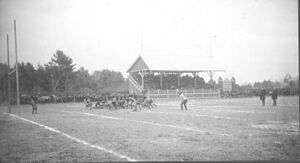
From the very beginning, Bates College offered a different choice compared to the more traditional and conservative Bowdoin College. There is a long history of rivalry and competition between the two colleges. This rivalry has been about things like social class, academic quality, and sports. While Bowdoin was historically seen as wealthier and more exclusive, Bates started some secret societies in 1881. This began to create a similar feeling of exclusivity at Bates.
Many Bowdoin alumni later helped develop Bates in the 1860s. Also, Bates alumni sometimes taught at Bowdoin. The founder of Bates, Oren Burbank Cheney, was also a leader at Bowdoin from 1860 to 1867. Cheney's only son, Horace, went to Bowdoin.
Bowdoin graduated its first black student in 1821, but due to campus issues, the second black student didn't graduate until 1864, 43 years later. As Bowdoin became less conservative and started admitting women in 1974, the relationship between the two colleges improved. Bates and Bowdoin began competing in sports in the 1870s. They now share one of the ten oldest NCAA Division III football rivalries in the United States.
Bates and Dartmouth College
Bates College has a connection with Dartmouth College because Bates's founder graduated from Dartmouth. He felt a strong bond with Dartmouth and was said to visit the grave of its founder, Eleazar Wheelock, weekly. This connection is also seen in many similarities between the two colleges. Many Bates buildings were designed to look like Dartmouth's architecture. Gridley J.F. Bryant, the architect, used similar designs for both colleges, with mint green roofs and white trim on brick buildings.
In 1920, Bates started the second oldest winter carnival in the United States, after Dartmouth (which started its in 1910). Both colleges also have the smallest student bodies in their respective athletic leagues. Because of these similarities, Bates is often seen as the Little Ivy counterpart to Dartmouth. Bates students can also choose to finish their engineering degrees at Dartmouth, earning a degree from both colleges. Bates students created the "Dartmouth Challenge" to playfully poke fun at Dartmouth's mascot, Keggy the Keg.
Social Class and Early Policies
Bates College's early policies of equality were not popular with everyone. Some early teachers and students, as well as critics from other colleges, worried about Bates's reputation when the first black and female students arrived in the 1850s and 1860s. The college, led by Cheney, also banned fraternities and sororities in its original charter. He believed they created unwanted exclusivity, which didn't fit with the Free Will Baptist idea of equality.
However, despite the ban, some Bates students tried to start secret societies in 1881. This topic was debated in the Bates Student newspaper in the late 1800s. In February 1920, during Prohibition, students again tried to form a secret society, called the "Cognac Club," but it was not successful. Some students at the college "desired more aristocratic company" like that found at Bowdoin College and other similar schools.
Although Bates had a reputation for equality in the late 1800s and early 1900s, by World War II, some people felt the school's reputation had become more elitist, like other similar schools. In the late 1940s, Bates became known for mainly educating white students from upper-middle-class to affluent backgrounds.
In the 1950s, the college put fences around the campus. This was an attempt to "represent boundaries between Bates and Lewiston" and create a "symbolic separation between the purity of the Academia Batesina and the underdeveloped city that surrounded them."
According to a 2017 article by The New York Times about income inequality, 18% of Bates students came from the wealthiest 1% of American families (who made about $525,000 or more per year). The average family income of students at Bates was $226,500. About 76% of students at Bates came from the top 20 percent of earners. In January 2017, Bates was reported to be the most expensive college in Maine.
Images for kids
-
The Gomes Chapel, named after Peter J. Gomes, chaplain of Harvard University and Bates class of 1965. The chapel is modeled after King's College Chapel, Cambridge.
-
Plaque on Hathorn Hall designating September 1, 1857 as the opening of the Maine State Seminary and August 23, 1863, as the opening of Bates College. However, official reference designates March 16, 1855 as the founding of the college–its charter date.


